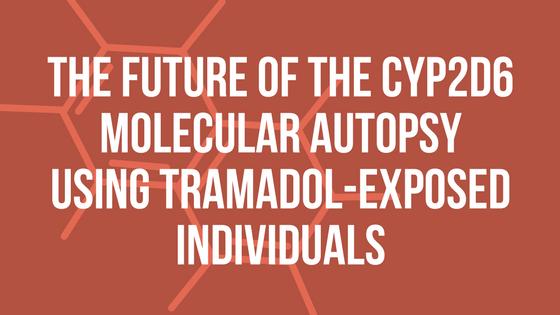Molecular autopsy describes the use of genetic data to aid in determining cause and/or manner of death in situations where traditional medico-legal autopsy is undetermined. Seminal papers in this field have used genetic variation in the cytochrome p450 family 2, subfamily D, polypeptide 6 (CYP2D6) locus to classify four main metabolizer phenotypes: poor, intermediate, extensive, and ultrarapid.
Written by: Frank Wendt, UNTHSC
These phenotypes are extensively studied in relation to the metabolism of various drugs, including tramadol, in numerous global populations; however, there is a paucity of data exploring how trans-acting metabolic enzymes impact the adverse drug reaction phenotype.
I presented the early stages of a multifaceted project [at ISHI 28] in collaboration with Dr. Antti Sajantila and his student Anna-Liina Rahikainen from the University of Helsinki in Helsinki, Finland. Their group collected approximately 200 autopsy samples between 2001 and 2012 that have been stored on FTA cards. They have also provided autopsy toxicology reports, generated at the time of collection.
Our group at the University of North Texas Health Science Center (UNTHSC) Center for Human Identification (CHI) has performed many in silico studies that have guided our use of these samples in three-stages of genotyping:
- long-PCR of the CYP2D6 locus followed by full-gene massively parallel sequencing (MPS)
- targeted exonic MPS of four genes involved in various stages of opiate ADME (absorption, distribution, metabolism, and excretion)
- a single nucleotide polymorphism array targeting 2.6 million loci across the genome to identify potentially informative single base changes and associated genes
Generation of genotype data is still underway but I plan to perform feature selection and supervised machine learning to evaluate the power of single nucleotide polymorphisms in five opiate-metabolism genes to predict metabolizer phenotype.
Our poster at ISHI 28 specifically describes a lot of summary data about our sample cohort, including the ICD-10 codes for cause/manner of death, and the presence of additional drugs in each samples’ toxicology report. Because we are working with real-world samples, it is important to consider these additional compound at some point in our analyses, but for now we are ignoring these variables to focus on tramadol metabolism. When our predictive model is complete, the accuracy can be checked using leave-one-out cross validation. In the event that our model cannot achieve 100% metabolizer phenotype prediction accuracy, we will explore relationships involving the additional drugs and possibly explain some of the missing accuracy.
The impact of my work is twofold. On one hand these data may elucidate cause and/or manner of death during post-mortem investigations. In doing so many, families may experience a sense of closure that is missing from cold cases, unexpected deaths, tragic accidents, and/or autopsy-negative cases. One the other hand, the individuals used for the work are deceased; however, these data are applicable to living patients as well in the form of personalized medicine and pharmacogenomics. By understanding what constellation of genetic markers is associated with death, the worst-case response to medications, clinicians can better infer which medications to prescribe their living patients to minimize undesirable results.
The rest of the year will involve lots of data generation and sequencing runs. Our analysis pipeline is pretty well laid out, so once the data is generated, I am optimistic that we will have quick turn around and dissemination to a larger audience. I am also preparing to graduate by end of summer 2018, so I am actively looking for post-doctoral research opportunities in pharmacogenomics, personalized medicine, and population genetics.
Would you like to see more articles like this? Subscribe to the ISHI blog below!


